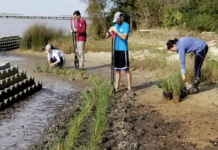
An interesting sea change is taking place regarding shorelines and it could be a growth area for ecologically-minded landscapers. Last week, the House passed legislation authored by Congressman Frank Pallone, Jr. (D-NJ) to help protect coastal communities from sea level rise and stronger storms. The Living Shorelines Act would create a federal grant program through the National Oceanic and Atmospheric Administration(NOAA) to assist states, localities, and non-governmental organizations (NGOs) in constructing living shorelines. Senators Kamala Harris (D-CA) and Chris Murphy (D-CT) have introduced the companion bill in the Senate.
What Is A Living Shoreline?

Living shorelines are a green infrastructure technique using native plants (marsh grasses, etc) with either a natural or engineered means (such as oyster beds, stones, dunes, etc) of breaking up wave energy to create and allow for the natural flood resilience of a healthy, growing shoreline ecosystem. Hard shorelines, on the other hand, such as seawalls or bulkheads, deflect wave energy. Research indicates that living shorelines are more resilient than bulkheads in protecting against the effects of hurricanes, according to NOAA. They also enhance ecosystem functions, which can improve water quality and wildlife habitat protection, say experts.
The Living Shorelines Act passed as part of a package of bills included in H.R. 729, the Coastal and Great Lakes Communities Enhancement Act, and has the support of the American Society for Landscape Architects. The legislation provides $50 million in federal funds that would be matched by state and local governments and NGOs applying for grants and projects. They would be monitored to measure and help determine best practices for future living shoreline projects. The bill would give priority consideration to projects in areas where a federal disaster has been declared in the past 10 years or that have a history of flooding.
Maryland Shores Up
Meanwhile, with over 7,000 of shoreline, much of it eroding, the state of Maryland has been at the forefront of the living shorelines effort. In 2008, Maryland passed the Living Shoreline Protection Act, requiring shoreline property owners to use natural solutions to prevent erosion unless they can prove such methods won’t work on their property.
According to a Pew Issue Brief published last month, Maryland’s ‘Living Shorelines’ Help Communities Become Resilient, “Since its inception, the [Maryland] loan program has distributed more than $3 million in loans for 475 living shoreline projects, protecting 200,036 linear feet of shoreline and creating over 3.75 million square feet of marsh.”
Lack Of Contractors
Yet, even with increasing support and legislation for living shorelines, it seems the workforce for these projects is still catching up. The Pew Issue Brief states, “…despite property owners’ growing interest in living shorelines, few contractors have been trained to create them, and some are reluctant to adopt them.”
The Mississippi-Alabama Sea Grant Consortium also sees a lack of contractors familiar with living shorelines. In Who installs living shoreline projects? published last March, Dr. Eric Sparks wrote, “Property owners always ask us who they should call to get a living shoreline installed, and we don’t have an answer for that. The truth is that it’s much easier to find a hardened shoreline contractor than a living shoreline contractor and with all the site planning and regulatory hoops, it’s clear why.” As a result, the Consortium is hosting workshops for landscapers, marine contractors, and consultants to demystify living shorelines and build a robust contractor workforce that can respond to demand.
There’s also an online Living Shorelines Academy, funded by the U.S. Environmental Protection Agency (EPA), and created by Restore America’s Estuaries and the North Carolina Coastal Federation, and their partners. It includes 10 different modules for design and construction professionals as well as many resources.
Look for more articles on living shoreline opportunities for landscapers in future reporting from Turf magazine.
Want to talk about Landscape Architecture And Design with fellow lawn care and landscape professionals? Join the discussions in the Landscape Architecture And Design Forum at www.expired-link.com.











![[VIDEO] Dickies®: Discover Workwear That’s Anything But Uniform](https://turfmagazine.com/wp-content/uploads/2023/06/1647663814-4b1a2a7742790a9b1e97a3b963477850192e1d6a9dfba9b07214a77bae25d6e3-d-218x150.jpg)





























![[VIDEO] Dickies®: Discover Workwear That’s Anything But Uniform](https://turfmagazine.com/wp-content/uploads/2023/06/1647663814-4b1a2a7742790a9b1e97a3b963477850192e1d6a9dfba9b07214a77bae25d6e3-d-324x160.jpg)